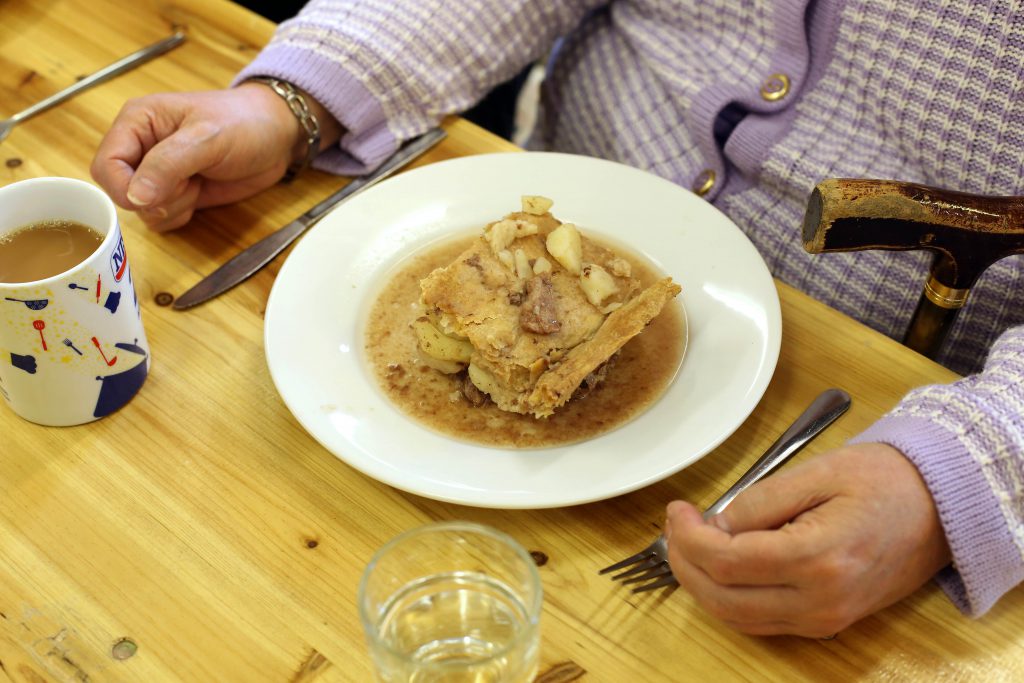Find out what inspired artist Pippa Hale to create her thought-provoking new commission, which explores a Workhouse Lunch. 50 volunteers helped to create Consumption, a filmed artwork, which is funded by Arts Council England.
Q&A
How did the idea for this piece of work begin?
Well, every work I make is site specific i.e. it responds to the context of a place so I always start there. I find history incredibly exciting and the overriding aim in all of the art works I create is to reveal some of that history and encourage visitors to experience it in a new way.
This project started with a site visit, looking at the museum in the context of Ripon and the history of the poor. Looking at the displays I was particularly struck by a photograph in the Guardians Room of inmates eating a Christmas meal from 1934 which got me thinking about food and nutrition. In the same room is a census from 1861 and it was here that I discovered the profile of inmates in the workhouse. I was very surprised to discover that nearly half of them were in the 70s, 80s and 90s when living conditions were so notoriously harsh.
What kind of research and planning did you have to do?
Once I knew which part of the workhouse history I was interested in, I could focus my research better. This involved desk research and talking to historians who are experts in this field. I am particularly grateful to Peter Higginbotham’s book ‘The Workhouse Cookbook’ and for conversations I had with James and Anthony at the museum and Peter Brears.
Why was it important to use real museum volunteers in the making of this piece?
Using the museum’s volunteers is an integral part of the work. I wanted them to have a real-life experience of what it would have been like to prepare and eat a meal from 1861 – the cuts of meat, the cooking techniques, the segregation of the sexes in the Dining Hall – so they can communicate that to visitors.
I’m also trying to draw direct parallels between two communities of older people who engage with the building, whether as an inmate in 1861 or a volunteer in 2017. The workhouse plays – and has played – an important role in terms of wellbeing in later life. The fact that so many inmates survived into older age was probably due to regular meals, familiar surroundings and a sense of community, albeit under harsh conditions. Today, the museum is a very social space where volunteers come together for friendship and to make a major contribution to the museum’s daily operations.
Do you feel you have achieved what you set out to do?
I hope so!
Have you enjoyed your first experience of making an art piece through film?
Yes, very much. As an artist, I’m a bit of a magpie really – I don’t stick to any one particular medium, rather I let the place and the idea lead the outcome. This is the first big event I’ve filmed and I wouldn’t have been able to do it without the support of the team at the museum and Rosie Reed-Hillman and Scott Dulson who shot and are editing the final work.
What has been the highlight for you?
Learning more about workhouses and meeting so many enthusiastic and friendly people.
What were some of the challenges today?
Trying to capture the moment in real time without letting the filming get in the way of the actual event or putting people off their conversations.
What would you like the audience to take away from this work?
Consumption has been about recreating an authentic workhouse meal from 1861 in the very same room inmates would have eaten, the volunteers dined today and in which the final work will be shown. I hope Consumption collapses the gap between the past and the present for visitors – there is something powerful about standing in such a historic space and sharing an experience that spans the centuries.
I also hope the work engages with the contemporary debate about wellbeing in later life. We’re all growing older and loneliness is a major challenge as families are increasingly dispersed and time pressured. How do we care for the elderly and what does that say about us as a society?
 Workhouse Museum
Workhouse Museum